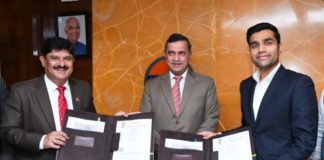Gautam Adani as one of the most amazing first-generation entrepreneurs
By RN Bhaskar
Doing business in India is not easy. This is what this author has tried to explain in his book Gautam Adani: Redefining business in India and the world. All first-generation entrepreneurs remain vulnerable to the circumstances that reign supreme during their times. Yet, they find ways to overcome them – sometimes by cutting corners — especially if they want to try reach global capacities and excellence.
Consider the Birlas. Take the case of the first-generation entrepreneur from this business house. Narayana Birla (1840–1909). He and “his adopted son, Baldeo Das Birla, made an enormous fortune by trading opium with China, and this formed the basis of the family’s fortune. With growing wealth and increasing confidence, Shiv Narayana Birla moved up the value chain and began chartering cargo ships in partnership with other Marwadi tradesmen to trade opium with China, thus by-passing British middlemen. To facilitate this, he moved to Bombay in 1863” (https://en.wikipedia.org/wiki/Birla_family).
Or take the Tatas. They along with other Parsis also were big traders in opium (https://economictimes.indiatimes.com/how-bombays-parsis-cracked-the-opium-trade/articleshow/28892310.cms).
So was David Sassoon, who controlled 17 textile mills in Mumbai and employed almost 60% of this city’s population during his time. One of his two sons, eventually stationed himself in China, and then moved to Sri Lanka (https://asiaconverge.com/2019/10/david-sassoon-the-biggest-wealth-generator-of-bombay/). True, opium smuggling was not illegal in those days, but it was certainly immoral.
Each of these first-generation entrepreneurs knew that making the first big stash of money requires cutting corners in more than one way.
Or take Dhirubhai Ambani, the man who taught India to think big and use the capital markets to finance large projects. He was adept in getting the government to change policies year after year, to ensure that his PTA got a better deal than DMT (Nusli Wadia was the biggest player for this raw material in those days). You can read about the Wadia vs Ambani: The Polyester Fight at https://edtimes.in/the-billionaire-who-fought-both-ambani-and-tata-and-is-still-around-to-tell-the-story/ .
Then look at Gautam Adani – another first-generation entrepreneur. His activities are currently under the scrutiny of regulators like SEBI, and hence the jury is still out. But during the interim it is extremely important to look at some things about Gautam Adani that set him apart from other entrepreneurs.
Unlike others, he chose to focus on infrastructure, without which no country can leapfrog over other wannabes in the world. He had already begun following an oft-repeated dictum – that when business interests and national interests are aligned, rapid growth is possible.
He intuitively knew that a country can import anything – petrochemicals, copper, steel and even food (Singapore grows little, but is still thriving because of excellent infrastructure and efficiency). But what it cannot import is ports, and other infrastructure. Today, as India steels itself for rapid growth, few realise that 44% of its GDP comes from export and import — 30% of its GDP comes from export and import of goods, and the rest from services.
Effectively Adani accounts for at least 25% of this 30% because that is his share of India’s exim trade. And this share is rising. Remove Adani from the scene, and you will see the nation lose around 8% of its GDP overnight. It could be a lot more if one adds the ancillary businesses related to ports and logistics.
Add to this the way Adani has become the largest player in thermal energy, which synergises harmoniously, with his coal trade. And do bear in mind, that he owns the largest coal mine in the world in Australia (10.5 billion tonnes of reserves). He has his own power plants there, and also owns a 200 km railway line there, a port in that country, and ships as well. This end to end logistics allows him to be more flexible in pricing coal compared to any other coal miner worldwide. No wonder, he supplies coal to Latin America, Africa and India (which may have a smaller share compared to other regions). It won’t be long before he begins supplying coal to China as well, because of his ability to offer the best pricing.
He is also the largest player in the organised edible oil market, despite fierce open market competition. There are other areas in which he is the largest player – city gas distribution, airport management, drone manufacture both for agriculture and military purposes (he has already begun exporting military drones) and solar power. No first generation entrepreneur has achieved so much, and become so crucially indispensable to the India growth story as has Gautam Adani.
Many of the Hindenberg claims are mere hogwash. The group is not the biggest con in history. All Hindenberg needed to do was to look over his shoulder in his own backyard. There is Enron – no assets, no real cashflows, just a chimera. Or Bernie Madoff (not strictly an industrialist). Then there is FTX of Sam Bankman-Fried. People who talk about India’s Enron moment have not studied the nature of fraud that was perpetrated on USA and the world with these companies. Do bear in mind that Adani has not been involved in any coal scams or telecom irregularities.
Adani has solid assets. His group has healthy cashflows – that is how he could reduce his debt from seven times his equity to just three times during the past three years. And he is a visionary who plays an immense geopolitical role with his port in Colombo and in Haifa.
Many of the violations cited are, at best, technical in nature. They do not represent financial frauds at all. For that you need to study Enron a bit more closely.










































COMMENTS